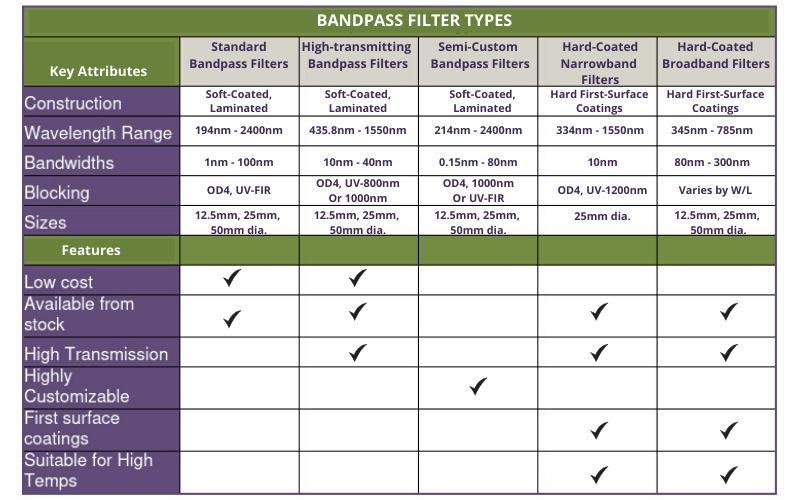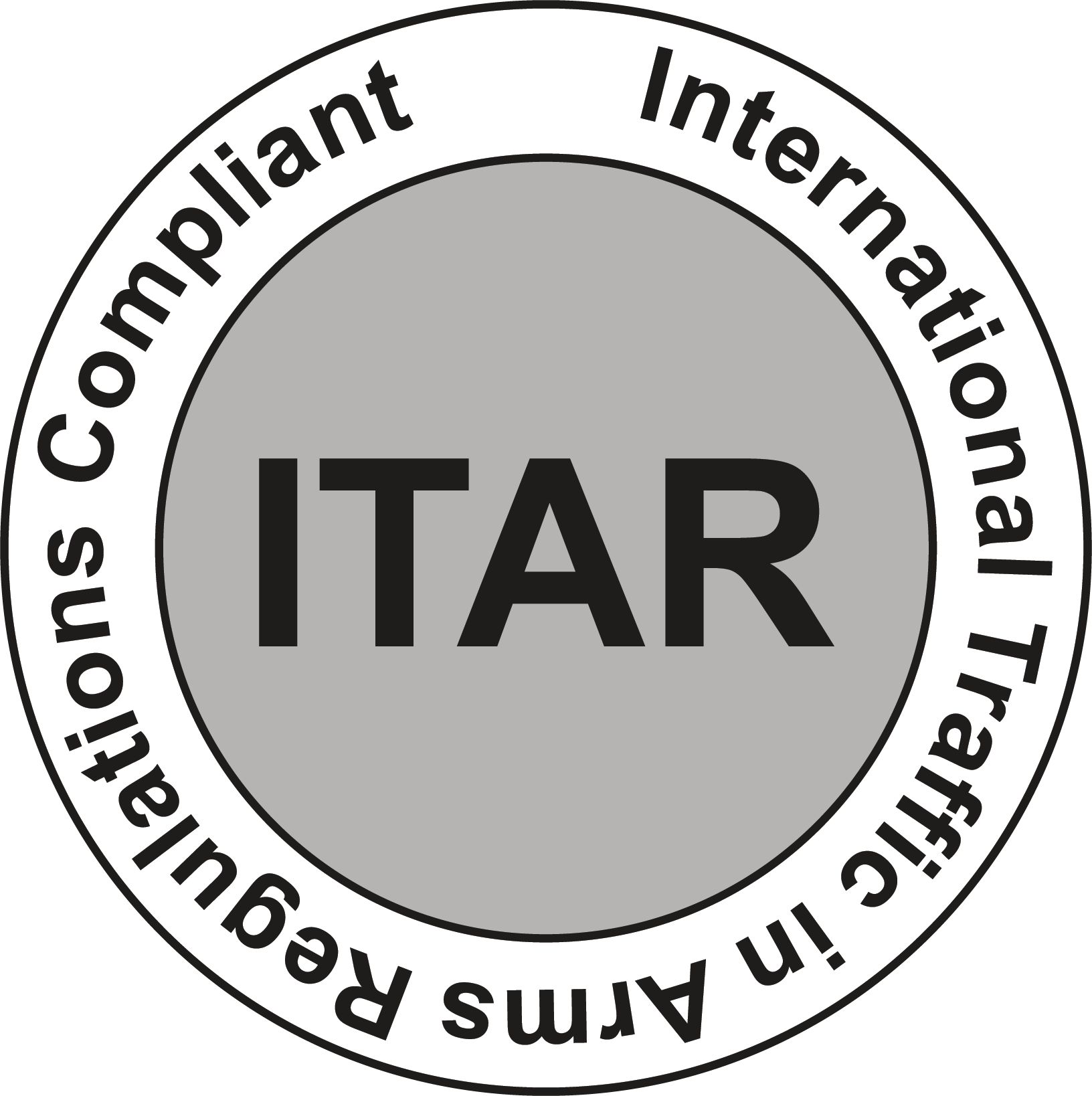BANDPASS FILTERS
There are a number of variations of an optical bandpass filter’s construction, and each has its advantages. Andover offers a variety of options so that you can select the best-suited filter type for your application. The table below summarizes the major features of the various types of filters listed above, to aid in quickly locating the type that is best suited for your application. If you would like advice from our technical sales staff, please contact us at info@andcorp.com.
Band-pass filters only transmit a certain wavelength band and block others. The width of such a filter is expressed in the wavelength range it lets through, and can be anything from much less than an Ångström to a few hundred nanometers. Such a filter can be made by combining an LP and an SP filter.
Bandpass filters are defined by three critical features: Center Wavelength (CWL)—the wavelength at the center of the passband. Full Width at Half Maximum (FWHM)—the bandwidth at 50% of the maximum transmission. Peak Transmission (T)—the wavelength of maximum transmission
Download our comprehensive 14-PAGE BANDPASS FILTER SELECTION GUIDE
Don't see what you need? Check out our Surplus Bandpass Filters and Surplus Hardcoat Filters

What is an Optical Bandpass Filter?
Optical bandpass filters are optical filters that pass one or more specified wavelength band(s) while blocking others. Bandpass filters are referred to by the wavelength range, also known as the passband, which they are designed to transmit. They are common filters suitable for a wide range of optical applications, including; environmental testing, colorimetry, flame photometry, fluorescence applications, UV sterilization, spectral radiometry, medical diagnostics, chemical analysis, machine vision, biotech instrumentation, medical devices, and laser line separation.
Optical bandpass filters are designed to transmit a well-defined band of energy in the electromagnetic spectrum. Andover offers one of the most extensive listings of standard "off-the-shelf" interference filters in this industry. We have a range of wavelengths range from the ultraviolet through the near-infrared and include many of the primary laser, mercury, biomedical and analytical spectral lines. Standard sizes include 12.5mm Ø, 25.0mm Ø, and 50.0mm Ø. All Andover filters are mounted in black anodized metal rings which provide an added measure of protection against chipping, scratching, and high humidity conditions. In addition, all filters have their part number permanently engraved on their edge and each filter is supplied with a calibrated spectral bandpass data curve at no-charge. Custom spectral data is available and will be quoted upon request. Shorter wavelengths, longer wavelengths, and custom shapes & sizes are available.
Bandpass Filter Fundamentals
Bandpass filters are one of the simplest and most economical ways to transmit a well-defined band of light and to reject all other unwanted radiation. Their design is essentially a thin film Fabry-Perot Interferometer formed by vacuum deposition techniques and consists of two reflecting stacks, separated by an even-order spacer layer. Each one of these structures is referred to as a cavity, and some filters may contain as many as eight cavities. There are many different variations of the Fabry-Perot type bandpass filter, but for this discussion, we will only consider the all-dielectric and metal-dielectric types.
The all-dielectric type consists of two highly reflecting mirrors separated by a dielectric spacer layer. These reflecting mirrors are constructed of alternating high and low refractive index materials and the reflectance of the stack is sometimes in excess of 99.99%. By varying the thickness of the spacer layer and or the number of reflecting layers, one can alter the central wavelength and bandwidth of the filter. This type of filter displays very high transmission in the passband, but, has a limited range of out-of-band blocking. To compensate for this deficiency, an additional blocking component is added, which is either all-dielectric or metal-dielectric depending upon the required blocking range. This additional blocking component will eliminate any unwanted out-of-band radiation but it will also reduce the overall throughput of the filter.
The metal-dielectric type is similar to the all-dielectric type except that it utilizes a metal spacer layer instead of a dielectric layer. Although this type of filter has excellent out-of-band blocking and high passband transmission, it lacks the sharp cut-on and cut-off slopes of the typical two and three cavity filters. The metal-dielectric type is mainly used for bandpass filters in the ultraviolet. However, one version, the induced transmission type, is used as an additional blocking component when rejection is required to the far-infrared.
Our exceptionally high level of stock, and unique processing methods, allow us to ship most items within two days after receipt of an order. If required, rush orders can usually be shipped within one day. All out-of-stock items will be shipped within two weeks after receipt of a purchase order.
See more:
What are the bandpass fundamentals?
Standard Bandpass
Andover’s Standard Bandpass filters have been the mainstay of the industry for decades. With our proprietary stabilization and sealing method, these filters will generally last for 10-20 years in the field. Their longevity, coupled with their low cost and ready availability, make these a great choice for most applications.
Semi-Custom Bandpass
In order to make it simple for customers to custom- tailor a bandpass filter for their application, Andover offers a line of Semi-Custom bandpass filters. Their construction is similar to both the Standard Bandpass and High-Transmitting bandpass filter offerings. We offer a wide selection of wavelengths, bandwidths, and sizes, and offer two blocking options.
High-Transmitting Bandpass
Andover’s High-Transmitting Optical Bandpass filters are a variant of the Standard Bandpass filter line. Designed for use with PMTs and photodiodes, they employ only dielectric coatings and have a blocking range tailored to the detector. This results in higher transmission than their fully-blocked counterparts. For your convenience, the high-transmitting bandpass filters are listed in the Standard Bandpass section and are highlighted for easy identification.
By tailoring the blocking range to match the detector, we can provide the maximum possible throughput while maintaining good blocking to meet the customer’s needs. Wavelengths include all popular laser, mercury biomedical, and analytical spectral lines. All filters are constructed using the same high-quality materials and methods as our standard bandpass filters, thus providing a highly stable, long-lasting filter.
These bandpass filters are designed for use in situations where far-infrared blocking is not required. They feature high transmission in the passband region and good blocking over a limited range. Theoretical transmission curves are available on request.
Hard-Coated Narrowband
Andover offers one of the broadest ranges of hard-coated narrowband filters in the industry. Our filters feature very high transmission and dense blocking from UV-1200nm. They are suitable for high-temperature applications.
Hard-Coated Broadband
This line of hard, first-surface coated filters was designed to cover the standard Raman spectroscopy lines. They feature very high transmission over a broad range about the wavelength of interest.
First-Surface UV Filters
Andover also offers a first-surface variant of its standard UV bandpass filter. The coatings are deposited on a single surface of a UV-grade Fused Silica substrate and include a hard-oxide overcoat for protection. See more at: UV Bandpass Filters for Sterilization
Benefits
- All coatings on a single external surface
- Sealed with a hard-oxide protective costing
- Coated on a single UV-Grade Fused Silica substrate
Common Applications
- Environmental testing
- UV Sterilization







